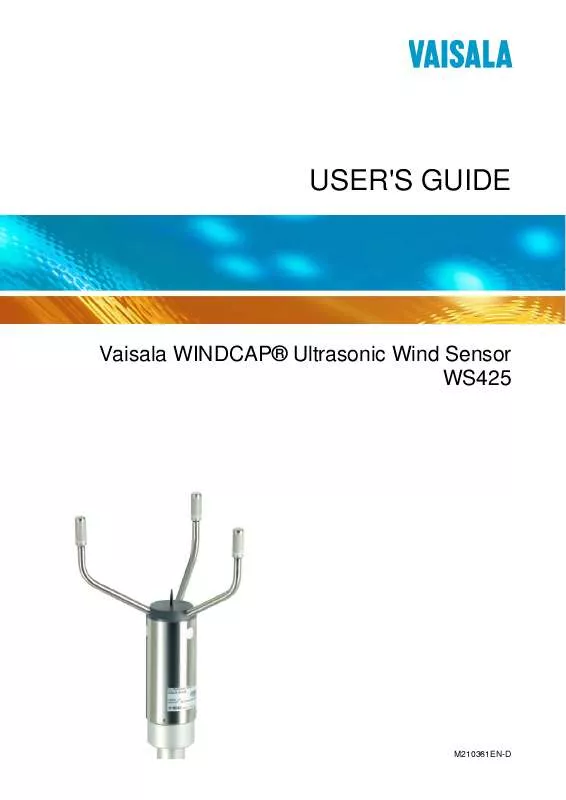User manual VAISALA WS425
Lastmanuals offers a socially driven service of sharing, storing and searching manuals related to use of hardware and software : user guide, owner's manual, quick start guide, technical datasheets... DON'T FORGET : ALWAYS READ THE USER GUIDE BEFORE BUYING !!!
If this document matches the user guide, instructions manual or user manual, feature sets, schematics you are looking for, download it now. Lastmanuals provides you a fast and easy access to the user manual VAISALA WS425. We hope that this VAISALA WS425 user guide will be useful to you.
Lastmanuals help download the user guide VAISALA WS425.
You may also download the following manuals related to this product:
Manual abstract: user guide VAISALA WS425
Detailed instructions for use are in the User's Guide.
[. . . ] USER'S GUIDE
Vaisala WINDCAP® Ultrasonic Wind Sensor WS425
M210361EN-D
PUBLISHED BY Vaisala Oyj P. O. Box 26 FI-00421 Helsinki Finland Phone (int. ): +358 9 8949 1 Fax: +358 9 8949 2227
Visit our Internet pages at http://www. vaisala. com/ © Vaisala 2009 No part of this manual may be reproduced in any form or by any means, electronic or mechanical (including photocopying), nor may its contents be communicated to a third party without prior written permission of the copyright holder. The contents are subject to change without prior notice. Please observe that this manual does not create any legally binding obligations for Vaisala towards the customer or end user. [. . . ] For the WS425 sensor, the time between each consecutive wind direction measurement is one second. Each wind direction measurement taken over the preceding averaging interval is summed and the sum is divided by the number of measurements. The same averaging interval is used for both the average wind speed and average wind direction. The sensor computes a true running average. If the data acquisition system requests data before the initial averaging interval completes, the sensor returns the best possible running average.
Averaging Method
These settings affect the calculation of wind speed and direction. The available options are as follows: a. Scalar averaging Vector averaging
Scalar Averaging When the scalar averaging is selected, the wind direction is a circular function with a discontinuity at due north, where 360° is equal to 0°. For example, 359° + 5° = + 4° and 0° - 5° = 355°.
VAISALA _______________________________________________________________________ 47
USER'S GUIDE____________________________________________________________________
The microprocessor translates this circular function to a linear function, that is, 359° + 5° is translated to 364° and 0° - 5° translates to - 5°. To calculate the scalar average wind direction, each translated wind direction measurement taken over the preceding averaging interval is summed and the sum is divided by the number of measurements. Vector Averaging Each x velocity and y velocity measurement over the averaging interval is added and then divided by the number of measurements. The resulting average x velocity and average y velocity are converted to polar direction and magnitude, returning as average direction in degrees and speed in the chosen units.
Output Interval
The output interval can be selected in full seconds between 1 and 9 seconds. These settings are independent of the averaging interval (configuration parameter 3, see section Average Interval on page 47). Regardless of the length of the output interval, the last measurement sample before transmission is always the last sample of the averaging window. Therefore, the transmitted data is always based on the latest measurements. If the output interval is set to zero (0), polling is used in data acquisition.
NOTE
When using the NMEA Standard as the operating mode (configuration parameter 1), there must be a non-zero setting for output interval since polling is not supported in the NMEA Standard mode.
Sensor ID Character
The sensor ID character must be a single capital letter from A to Z. Numbers or small letters are not accepted. After an ID is defined for a sensor, the configuration menu can be opened by typing open <id>. This is useful if several sensors are sharing the same communication line. When running the NMEA Extended or WAT11 mode, the sensor ID is part of the polling string.
48 __________________________________________________________________ M210361EN-D
Chapter 4 ________________________________________________________________ Operation
Wind Direction Coast Threshold
At very low wind speeds, the measured wind direction is meaningless. Therefore, you can specify a direction coast speed. When the measured wind speed drops below the direction coast speed, the calculations use the last wind direction that occurred while the wind speed WS at or above the direction coast speed to average wind direction. You can specify a direction coast speed between 0. 0 and 9. 9 units of measurement. [. . . ] After this, the programmed communication parameters will become effective. You have 5 seconds time to type: open<Enter> Make sure that the sensor is already on when you type the first letter. If you do not succeed, try several times and check your connections. After a successful OPEN command, the sensor should display a configuration menu. [. . . ]
DISCLAIMER TO DOWNLOAD THE USER GUIDE VAISALA WS425 Lastmanuals offers a socially driven service of sharing, storing and searching manuals related to use of hardware and software : user guide, owner's manual, quick start guide, technical datasheets...manual VAISALA WS425


 VAISALA WS425 DATASHEET (426 ko)
VAISALA WS425 DATASHEET (426 ko)
